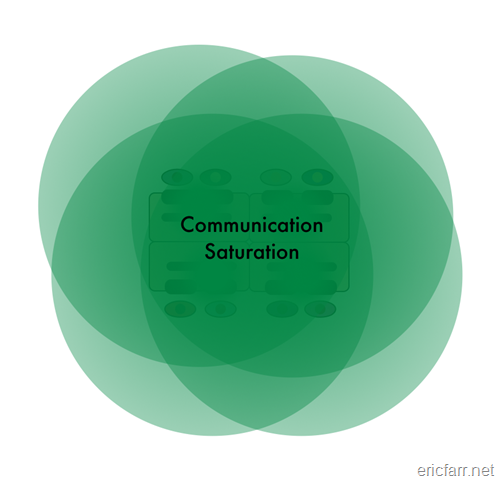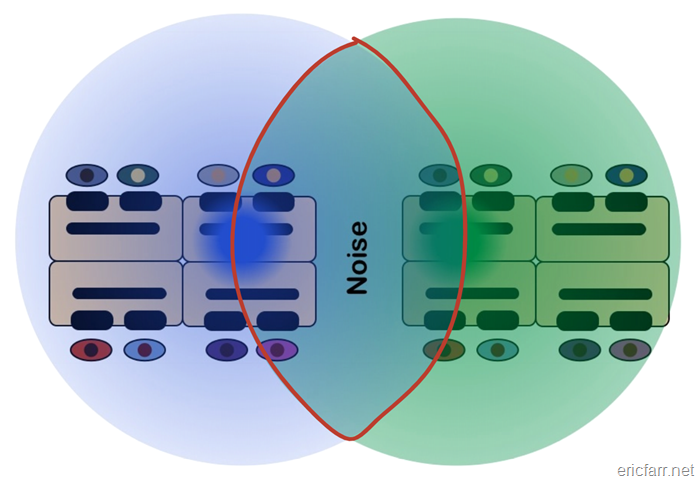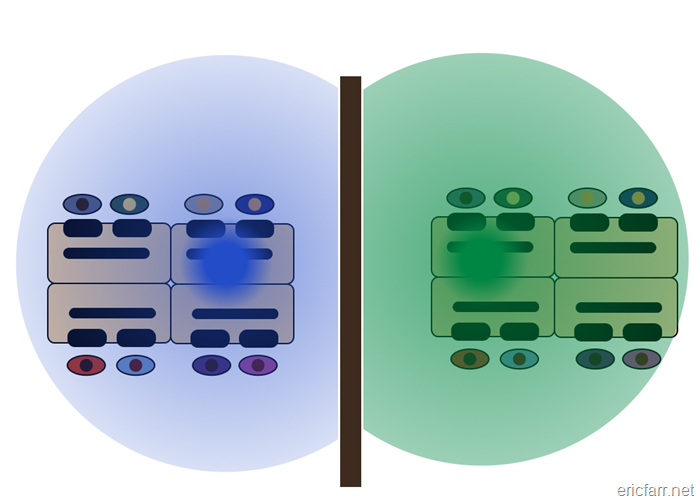I see this far too often. Well-meaning software organizations embracing agile software development tear down the walls in order to open up the space and allow easier collaboration. This sounds great, and it’s cheap. An easy win, right? Not if it’s done without some care and thought.
Premise 1: Irrelevant conversations are distractions.
Human beings are trained to pick other human beings’ voices out of the background noise and pay attention to them. There is little that is more distracting to concentration than hearing a conversation that has nothing to do with what you are working on.
Premise 2: A team is a group of people working toward a common goal.
If a team is really acting as a team, there is nothing that one subset of the team could be working on that is irrelevant to the rest of the team.
Imagine Team Green working in an open team room, paired at stations with one monitor and dual mice and keyboards…
Let’s say that pair number 1 is having a conversation…
That conversation is heard by all other members of the team. Because Team Green is a team, the fact that the whole team can hear it is a good thing. I cannot count how many times I have seen this…
Pair #1 overhears pair #2 getting stuck on some problem that sounds familiar. Pair #1 stops and gets involved in what pair #2 is doing. The four people discuss the problem and solve it, based largely on some previous experience that someone on pair #1 had. If one pair had not overheard the other pair struggling, they might have wasted a whole day (or at least until the next stand-up).
Now imagine Team Green is really busy and all working and talking…
I first heard this situations referred to as communication saturation by Jeff Sutherland, but I think he got it from Jim Coplien. Here we have everyone able to hear every other conversation. If a stranger were to come upon this team area, it would sound like noise. But to a high-performing agile software team, it is completely natural because every conversation is related to furthering the goal for this iteration.
Now imagine we have a collaborative, high-performing Team Blue…
Team Blue is enjoying the same open space benefit that Team Green is. Now imagine we take our open-spaces-are-good momentum and co-locate Team Green and Team Blue…
Now we have green conversations in the blue team area and green conversations in the blue area. This is not good. We now have noise distracting both teams.
If the blue conversations are as useful to the green team as green conversations, then you are not doing team based development.
There are two possible remedies: create more space between the teams, put up acoustically meaningful walls, or both.
The bottom line: open spaces and shared conversations are good only within a team, not between teams.







Pingback: Attributes of a Good Team Room | The Farr Side
I am a bit skeptical about the postulate. The resulting performance depends on many factors that are not elicited as experimental variables here. If the two teams are working on one product then I could well imagine benefits from cross-team background noise. If they are not working on the same product but are in the same enterprise I can still imagine some (though much smaller) benefit from cultural cross-pollination.
I expect that you need more instrumentation and calibration of these results before making the claims you make. In our research we didn’t find any knee in communication saturation. We did find a knee in team size (and this is well-known from other research). A more disciplined set of definitions would help remove the existing confusion in my inability to distinguish between these two in your claims. I firmly believe that they are different.
As a practitioner, and not a researcher, this post was motivated by my personal experience. I’ve seen too many cases where the people determining the office layout have only a superficial understanding of the dynamics of the people using the space. I’ve see great benefits from team co-location and removal of walls. I’ve also seen teams struggle in spaces that are wide open and give the team no sense of their own space within the larger space.
I’d love to see rigorous research into the dynamics involved in these situations. What is the minimum amount of visual and auditory privacy required for a team? What are the best ways to facilitate a team’s effective workspace while fostering healthy cross-team interaction? How about some sample floor plans for multiple interrelated teams within an organization?